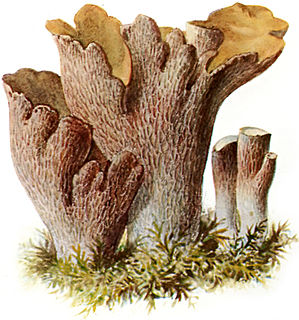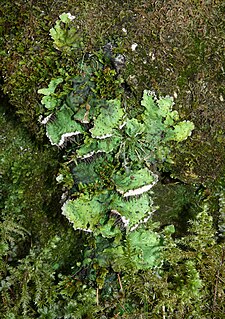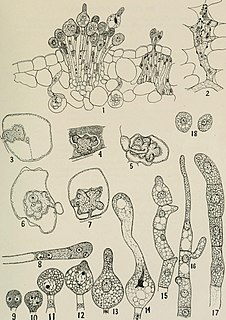
The Stereaceae are a family of corticioid fungi in the Russulales order. Species in the family have a widespread distribution, are lignicolous or terrestrial, and typically saprobic. According to the Dictionary of the Fungi, the family contains 22 genera and 125 species.

The Pucciniaceae are a family of rust fungi that cause plant diseases, mainly on cereals such as wheat. The family contains 20 genera and over 4900 species.

The Gomphaceae are a diverse family of fungi belonging in what is classically known as the Phallales or cladistically as the gomphoid-phalloid clade. The family has 13 genera and 287 species.

The Botryosphaeriaceae are a family of sac fungi. It is the only representative of the order Botryosphaeriales. According to a 2008 estimate, the family contains 26 genera and over 1500 species.

The Taphrinomycetes are a class of ascomycete fungi belonging to the subdivision Taphrinomycotina. It includes the single order Taphrinales, which includes 2 families, 8 genera and 140 species.

Rhizopogonaceae are a family of fungi in the order Boletales. The family, first named and described by botanists Ernst Albert Gäumann and Carroll William Dodge in 1928, contains 2 genera and 151 species. The genus Fevansia, formerly thought to belong in the Rhizopogonaceae, was found to belong in the Albatrellaceae in a molecular phylogenetics study.

The Phacidiaceae are a family of fungi in the order Helotiales. According to a 2008 estimate, the family contains seven genera and 148 species.

The Leotiaceae are a family of fungi in the order Leotiales. Species in this family are saprobic, and have a wide distribution, especially in temperate regions. The family contains 7 genera and 34 species.
The Hemiphacidiaceae are a family of fungi in the order Helotiales. Although the type genus was originally Hemiphacidium, it has since been renamed to Sarcotrochila. The 26 species in this family are limited in distribution to northern temperate zones.

The Helotiaceae are a family of fungi in the order Helotiales. The distribution of species in the family are widespread, and typically found in tropical areas. There are 117 genera and 826 species in the family.

The Bulgariaceae are a family of fungi in the order Helotiales. Species are found in northern and southern temperate regions. The family contains four genera and seven species.
The Cuniculitremaceae are a family of fungi in the order Tremellales. Cuniculitrema, the teleomorphic taxon, is known in southern Germany and Switzerland, while the anamorphic taxa have a wider distribution. The four genera of the family Cuniculitremaceae have a combined total of 25 species.

The Peniophoraceae are a family of fungi in the order Russulales. Species of this family have a cosmopolitan distribution and are mostly saprobic, causing rots of standing and fallen wood. According to a 2008 estimate, the family contains 7 genera and 88 species.

The Peltigeraceae are a lichenized family of fungi in the order Peltigerales. Species of this family have a widespread distribution but are especially prevalent in temperate regions. The family contains two genera and 101 species.

The Choanephoraceae are a family of fungi in the order Mucorales. Members of this family are found mostly in the tropics or subtropics, and only rarely in temperate zones. The family currently includes species formerly classified in the family Gilbertellaceae.

The Lecanoromycetidae are a subclass of fungi in the class Lecanoromycetes. This subclass contains three orders: the Lecanorales, the Peltigerales, and the Teloschistales.

The Teloschistales are an order of mostly lichen-forming fungi belonging to the class Lecanoromycetes in the division Ascomycota. According to one 2008 estimate, the order contains 5 families, 66 genera, and 1954 species.

The Exobasidiaceae are a family of fungi in the division Basidiomycota, order Exobasidiales. The family contains 5 genera and 56 species. Species in the family have a widespread distribution, especially in temperate areas. Members of the Exobasidiaceae are plant pathogens that grow on the leaves of plants, especially those in the family Ericaceae.

The Chaconiaceae are a family of rust fungi in the order Pucciniales. The family contains 8 genera and 75 species. Most species have a tropical distribution. Maravalia cryptostegiae has been used with success as a biocontrol agent against rubber vine in Australia.

The Leptosphaeriaceae are a family of fungi in the order Pleosporales. The family was circumscribed by mycologist Margaret E. Barr in 1987. According to the Dictionary of the Fungi, the family contains 8 genera and 302 species. The family has a widespread distribution, but is especially prevalent in temperate regions. Species are either saprobic or grow as nectrotrophs on the stems or leaves of plants.


















